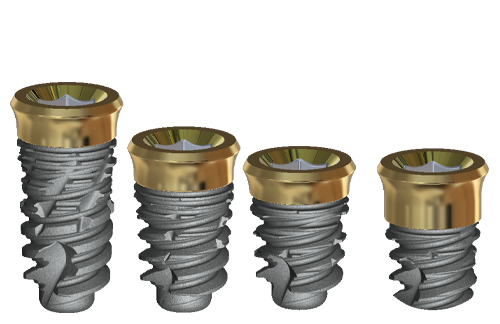The benefits of Tissue-level implants
The benefits of Tissue-level implants
Peri-implantitis is the most common challenge for patients with dental implants. Tissue-level implants are a viable alternative to bone-level implants that minimize the risk of peri-implantitis, reduce cost, time in the clinic, and treatment complexity for edentulous patients [1]. Specifically, the design of Dentalis® Gold tissue-level implants combats this pathology by decreasing bacterial colonization and resulting bone resorption (bone loss).
Because the connection between the implant screw and the tooth restoration rests at the level of the gum line, enabling accessibility and visibility for proper dental hygiene, a tissue level implant is simpler for the patient to clean and maintain.
Tissue-level implants allow for non-submerged healing by design: they have the abutment on top of the implant as one component. The treatment strategy allows for both soft tissue adhesion to the implant abutment and osseointegration during the same healing phase after implantation [2]. One-stage treatment allows for minimal disturbance to the area, reducing inflammation and risk of infection. Tissue-level implants decrease the size of the micro-gap between the implant and the abutment surface. The micro-gap directly affects the bacterial infiltration of the implant, which is precisely related to peri-implantitis [3]. The larger microgap occurring with bone-level implants means that there will be higher deformation of titanium, resulting in more stress in the implant. Mechanical stress on the implant is another leading cause of bone resorption at the peri-implant site [4].
Stress distribution of implants is mediated by other factors as well, such as crown height and type of implant connection. Tissue-level implants have been shown to reduce the stress level by 50% compared to bone-level implants because the transmucosal part of the tissue-level implant decreases the length of the crown height and increases the diameter of connection [4].
While it is known that the size of the micro-gap and amount of mechanical stress on the implant are important indicators of the success of the implant, it has also been shown that patients with a history of periodontitis, or underlying health conditions such as diabetes or osteoporosis, have an increased risk for peri-implantitis with bone-level implants. A recent study conducted by Marchio et. al showed that tissue-level implants offer patients with the above clinical indications a distinct advantage for implant survival. The group showed that tissue-level implants neutralize the effect of possible underlying diseases that lead to higher failure rates [5]. An additional study conducted on a Swedish population showed that tissue-level implants have a significantly lower risk of peri-implantitis for patients with a history of periodontitis [6].

Dentalis® Gold tissue-level implants provide a viable treatment option both aesthetically and functionally for edentulous patients by maintaining hard and soft tissue health and reducing the risk for peri-implantitis and associated bone loss.
To learn more: [email protected]
References
- Canullo, L., et al., Tissue-level versus bone-level single implants in the anterior area rehabilitated with feather-edge crowns on conical implant abutments: An up to 5-year retrospective study. The Journal of Prosthetic Dentistry, 2022. 128(5): p. 936-941.
- Zhao, P. and J. Shi, Clinical effect of implant healing between submerged and non-submerged dental implants: a randomized controlled study. Shanghai kou Qiang yi xue= Shanghai Journal of Stomatology, 2010. 19(6): p. 594-597.
- King, G.N., et al., Influence of the size of the microgap on crestal bone levels in non‐submerged dental implants: A radiographic study in the canine mandible. Journal of periodontology, 2002. 73(10): p. 1111-1117.
- Kim, J.-H., et al., Biomechanical stress and microgap analysis of bone-level and tissue-level implant abutment structure according to the five different directions of occlusal loads. The Journal of Advanced Prosthodontics, 2020. 12(5): p. 316.
- Marchio, V., et al., Tissue level implants in healthy versus medically compromised patients: a cohort comparative study. Minerva Stomatologica, 2020. 69(5): p. 295-301.
- Derks, J., et al., Effectiveness of implant therapy analyzed in a Swedish population: prevalence of peri-implantitis. Journal of dental research, 2016. 95(1): p. 43-49.
